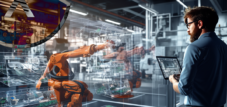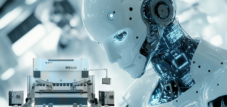Published on: April 9, 2025 / update from: April 9, 2025 - Author: Konrad Wolfenstein
Up to 60% savings: Use used robots in production
Sink costs, increase efficiency: the future with recycled robots
The integration of used robots into existing manufacturing environments is a strategic opportunity in order to achieve automation goals cost -effective and sustainably. Through the combination of proven technologies with modern integration methods, companies can implement productivity increases of up to 35%, while reducing investment costs by 40–60% compared to new purchases. The following report systematically analyzes the key factors for successful implementation, based on current practical examples and technological developments.
Suitable for:
Strategic preparation and process analysis
Before a used robot is integrated into the production, a comprehensive analysis of the existing production processes is essential. Studies by the Fraunhofer IPA show that 68% of all automation projects fail because applications have not been precisely defined.
Feasibility studies and ROI calculations
In addition to acquisition costs, a valid profitability analysis must also take into account the surrounding walls, energy consumption and maintenance costs. For a used KUKA KR 210, amortization times of 18–24 months can typically be calculated based on savings of 2.3 personal classes per day. Tools such as the Robodk simulation platform enable precise calculations by digital twins that map real production scenarios.
Compatibility test of existing infrastructure
The integration of used robots requires a detailed assessment of the interface compatibility. Older control systems such as KUKA KRC2 can be retrofitted by retrofit solutions with OPC UA interfaces to enable connection to IIoT platforms. Critical factors include:
- Voltage supply (400V vs. 480V systems)
- Feldbus protocols (Profinet, Ethercat, Devicenet)
- Security concepts according to ISO 10218-2
Selection and procurement of optimized robot systems
The used market today offers over 120 different robot models with standardized certifications. Platforms such as Surplex.com list over 500 overhauled units per month, including ABB IRB 6600 palletizers or Fanuc M-710IC handling robots.
General overhaul stands and quality assurance
Leading providers such as Kuka Retrofit Services guarantee through 72-point checks:
- Exchange of all wear parts (gearbox, seals)
- Calibration to ± 0.05mm repeat accuracy
- 12 months of full guarantee including spare parts logistics
- Documented mileage under 20,000 operating hours are considered a guideline for a remaining lifespan of at least 5 years.
Modularity and expandability
Modern used robots such as the ABB IRB 4600 can be retrofitted by modular gripper systems (e.g. Schunk EGP) and vision sensors (Keyence CV-X series). This flexibility reduces adaptation costs by up to 30% compared to customer -specific special solutions.
Technical implementation and plant networking
The physical integration of used robots requires a three -stage procedure that combines mechanical, electrical and information technology aspects.
Mechanical integration and security concepts
Brownfield integrations in existing production lines often use mobile platforms such as Omron LD-250 FTS, which enable flexible positioning. Security fences according to ISO 13857 must ensure a minimum distance of 1,500mm for robots at 2m/s speed. Alternatively, collaborative solutions with Sick Nanoscan3 scanners enable human-robot interaction without physical separation.
Control connection
The networking of used robots with PLC controls takes place via gateway solutions such as B&R Automation PC 3100, the Legacy protocol (DevicNet) convert to OPC UA. For ABB IRC5 systems, the Auerswald Profibus DP extension card has proven itself, which enables integration into Siemens S7-1500 environments.
Software integration and programming
Low code platforms such as Artiminds RPS simplify the programming of used robots through:
- Drag-and-drop movement planning
- Automatic collision recognition
- Power-moment sensor integration
- For KUKA systems, the KUKA.Officelite package enables offline programming on virtual controllers, reduced learning times by 70%.
Suitable for:
Business optimization and long -term support
The successful operation of used robots requires continuous optimization and adapted maintenance concepts.
Predictive maintenance strategies
Sensor data of used robots can be integrated into cloud platforms such as ABB Ability ™ via IIOT gateways (e.g. Cisco IR1101). Machine learning models analyze vibration patterns and electricity recordings to:
- Gear damage to detect 800 operating hours before failure
- To reduce energy consumption by optimized acceleration profiles by 15%
Spare parts management and retrofit options
Certified user robot providers such as Eurobots maintain spare parts warehouse with over 50,000 original components. For example, 92% of all spare parts are still available for the FANUC R-20000IB 15 years after initial production. Modularly retrofitted axes (e.g. Kuka Quantec-ha) extend the range of older models by up to 1.2m.
Sustainability and profitability consideration
The reuse of industrial robots reduces CO2 footprint by 8.5 tons per unit-equivalent to the annual compensation of 380. At the same time, the integration of used systems enables:
- 75% lower environmental impact on new devices
- 60–80% material reference to the production circuit
- Economic calculations for a medium -sized metal processor show in two used welding robots when investing € 120,000:
- ROI after 22 months
- Annual cost savings: € 85,000 by reduced committee rate
- Capacity increase: 1,200 additional components/month
Future -proof automation by circular economy
The integration of used robots develops into the standard in industrial automation. With average performance values of 85% compared to new devices at halved costs, SMEs in particular offer bridge technology in Industry 4.0. The combination of retrofittable control systems, modular periphery and cloud -based surveillance tools creates future -proof solutions that can be dynamically adapted to changed production requirements. Companies that take this path at the same time position themselves systematically as a pioneer of a sustainable circular economy that systematically combines economy and ecology.
Suitable for:
Your global marketing and business development partner
☑️ Our business language is English or German
☑️ NEW: Correspondence in your national language!
I would be happy to serve you and my team as a personal advisor.
You can contact me by filling out the contact form or simply call me on +49 89 89 674 804 (Munich) . My email address is: wolfenstein ∂ xpert.digital
I'm looking forward to our joint project.














